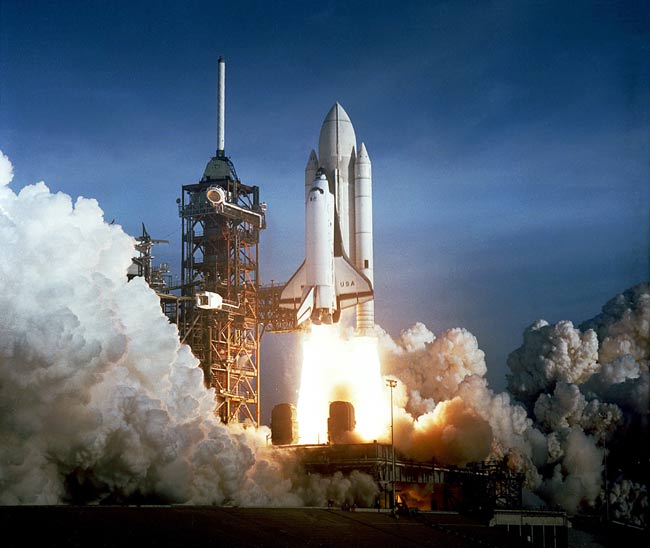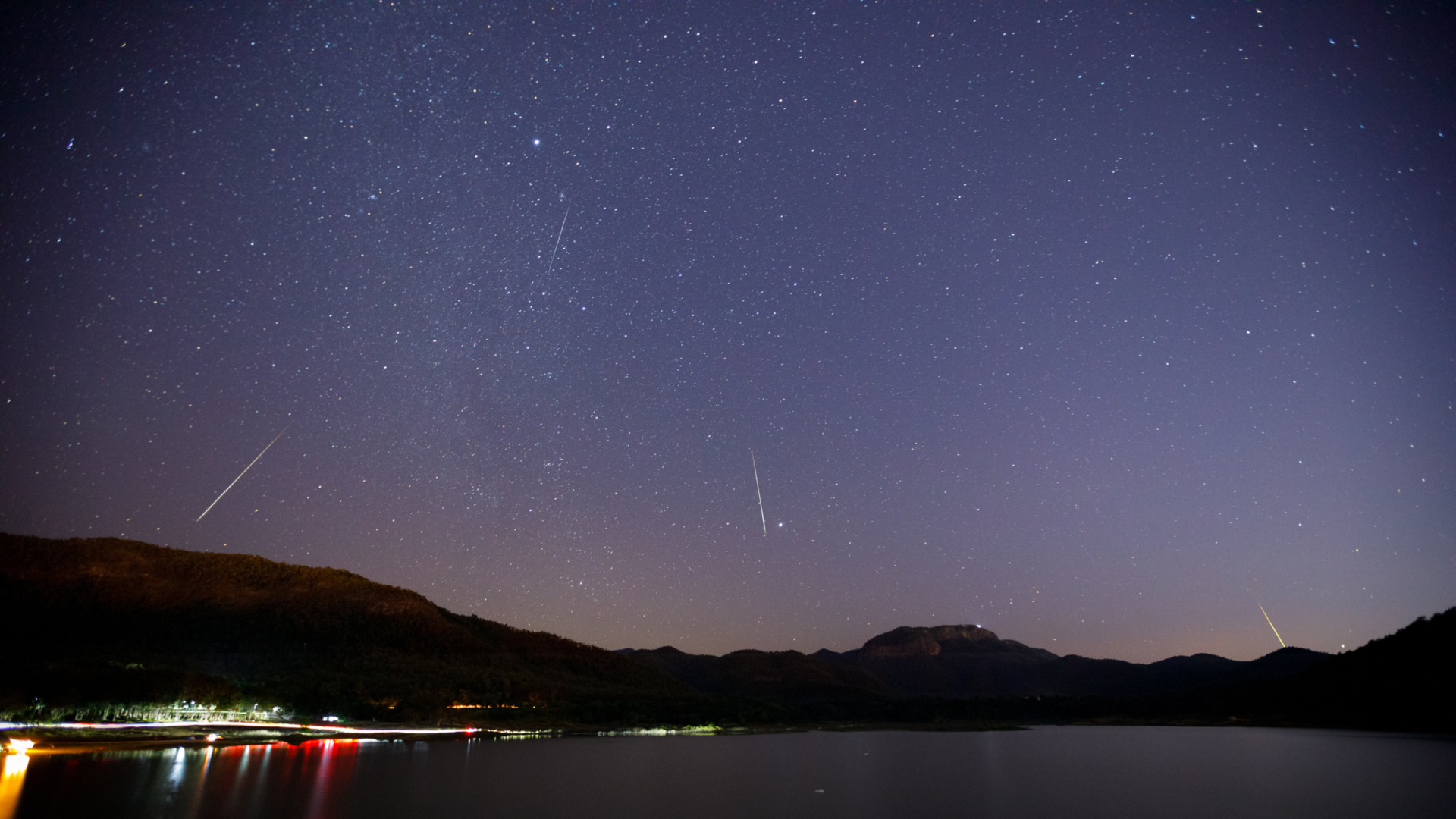The Ultimate Test Flight: NASA's Shuttle Fleet at 25

Two astronauts, one space plane and NASA's shuttle era began today in 1981 as the Columbia orbiter launched into the morning skies above Cape Canaveral, Florida.
NASA TV will present a series to STS-1 anniversary events beginning with Young and Crippen's reflections at 10:00 a.m. EDT. Click here. |
Columbia, NASA's first spaceworthy shuttle, launched into orbit on its maiden STS-1 flight at 7:00 a.m. EDT (1100 GMT) with veteran Apollo and Gemini astronaut John Young at the helm and first-time spaceflyer Robert Crippen as pilot.
"To fly on the first one was a test pilot's dream," Crippen told SPACE.com 25 years after his spaceflight debut. "It was an exciting ride."
Today, NASA's shuttle fleet is headed towards a 2010 retirement without ever attaining its goal of quick and affordable space access. The fleet's technical accomplishments as the world's first reusable spacecraft are marred by two fatal accidents that claimed the lives of 14 astronauts and two orbiters; Challenger in 1986 and Columbia herself in 2003.
"We've learned a great deal," Young told SPACE.com. "And that's why you fly a test flight, so you can learn."
Breaking space news, the latest updates on rocket launches, skywatching events and more!
54 Hours of firsts
Young and Crippen spent more than 54 hours in Earth orbit shaking down Columbia.
They opened its payload bay doors, checked its reaction control thrusters and put the orbiter through its paces before landing at Edwards Air Force Base in California.
"Everything worked," Young told a crowd of 1,000 shuttle workers at NASA's Kennedy Space Center in Florida last week. "I was really surprised."
Unlike today, when NASA flight controllers are in near-constant contact with orbiter crews via satellites, STS-1 depended on ground communications systems to speak with mission control. That dependency led to some tense moments as the STS-1 crew made their plunge through the Earth's atmosphere with only Columbia's heat-resistant ceramic tiles and blankets for protection.
Back on Earth, Wayne Hale - then a propulsion systems support flight controller at NASA's Johnson Space Center (JSC) in Houston - waited anxiously for Columbia to radio in.
"We had talked to them from the Guam relay station and gave them their last weather report and then we had about 30 minutes before they came over the horizon at Edwards," said Hale, who is now NASA's space shuttle program manager at JSC. "That was maybe the longest 30 minutes of my life."
Tiles and other surprises
| Image Gallery: NASA's First Shuttle Flight VIDEO: STS-1 Commander John Young Remembers Columbia's Debut | Row 0 - Cell 1 | Image Gallery: NASA's First Shuttle Flight VIDEO: STS-1 Commander John Young Remembers Columbia's Debut |
| Row 1 - Cell 0 | ||
| Image Gallery: NASA's First Shuttle Flight VIDEO: STS-1 Commander John Young Remembers Columbia's Debut |
There were some unexpected glitches on Columbia's first flight.
A pressure shockwave from the orbiter's solid rocket boosters damaged a strut that supports its forward thruster assembly on the launch pad. Water dampers were later installed to mute the shockwave's effects in future launches.
Columbia also had a track record for losing bits of the 30,000-tile heat shield during assembly, Crippen said. Some of those tiles - 16 in all - popped free from the orbiter during STS-1 with 148 others sustaining damage.
The disastrous consequences of heat shield damage were made clear on Columbia's last flight, STS-107 in early 2003, when fuel tank foam breached the orbiter's wing at launch and led to its loss during reentry.
"I think if we knew then what we know now, we'd have probably been a lot more nervous," Young said of the risks he and Crippen accepted for their test flight.
Even strapping the astronauts into the orbiter prompted some unexpected hitches, explained Loren Shriver, who helped secure Young and Crippen into their seats.
"The oxygen hoses to their masks had to be hooked up just right," Shriver said, adding that he ended up using pliers to wedge Crippen's hose into place to give him air. "That was, hopefully, my contribution to the success of that mission."
A matter of cost
NASA's space shuttles have never realized the space agency's initial hopes of frequent flights - up to 50 flights a year at first - and relatively low-cost launches.
The shuttle transportation system (STS) cost about $10 billion in 1981 dollars to develop for Columbia's first flight, with the orbiter alone priced at $1 billion, NASA officials said.
Prior to the Columbia accident, when NASA flew an average of five missions per year, shuttle launches cost about $900 million from end-to-end, the space agency said.
"When it came to cost effectiveness, we didn't do as well," said Bo Bejmuk, the orbiter program director at Boeing. "Unfortunately the shuttle fell short this dream of bringing to America and the world of bringing access to space."
NASA's hopes for two-week turnarounds between shuttle missions also evaporated once it became clear that Columbia and its orbiter brethren required much more tile work and other maintenance between flights.
"Certainly, when you're essentially taking apart a vehicle and putting it back together again, you lose a lot of features that reusability would give you," said former NASA historian Roger Launius, now chair of the Division of Space History at the Smithsonian Institution's National Air and Space Museum in Washington, D.C., in an interview. "But it's really served as an exceptional spaceflight platform."
With a capability of hauling 40,000 pounds (18,143 kilograms) of cargo to orbit and back, the shuttle boasted a performance still unmatched today, Launius added.
'A fantastic flying machine'
Despite its unrealized ambitions, Columbia and NASA's subsequent shuttles racked up an amazing number of accomplishments, the shining jewels of which are the launch of the Hubble Space Telescope and the initial assembly of the International Space Station.
"We've learned a lot about the shuttle and it's a fantastic flying machine," Crippen said. "But we've proven that it also requires a lot of tender loving care."
A total of 294 astronauts and cosmonauts have flown aboard NASA's space shuttles - Atlantis, Discovery and Endeavour are those three that remain - during launch and landing, continuing a chain of human spaceflight that began 45 years ago today with cosmonaut Yuri Gagarin's historic 1961 space shot.
"They were all great, but that first one will always stand out," Crippen said of his four shuttle flights. "I'd go do it again tomorrow if they wouldn't make me train for a year."
| Image Gallery: Hail Columbia! | Row 0 - Cell 1 | Image Gallery: Hail Columbia! | Row 0 - Cell 3 | Image Gallery: Crew Photos from Columbia's Final Flight | Row 0 - Cell 5 | Image Gallery: Crew Photos from Columbia's Final Flight |
| Row 1 - Cell 0 | ||||||
| Image Gallery: Hail Columbia! | ||||||
| Row 3 - Cell 0 | ||||||
| Image Gallery: Crew Photos from Columbia's Final Flight |

Tariq is the award-winning Editor-in-Chief of Space.com and joined the team in 2001. He covers human spaceflight, as well as skywatching and entertainment. He became Space.com's Editor-in-Chief in 2019. Before joining Space.com, Tariq was a staff reporter for The Los Angeles Times covering education and city beats in La Habra, Fullerton and Huntington Beach. He's a recipient of the 2022 Harry Kolcum Award for excellence in space reporting and the 2025 Space Pioneer Award from the National Space Society. He is an Eagle Scout and Space Camp alum with journalism degrees from the USC and NYU. You can find Tariq at Space.com and as the co-host to the This Week In Space podcast on the TWiT network. To see his latest project, you can follow Tariq on Twitter @tariqjmalik.
